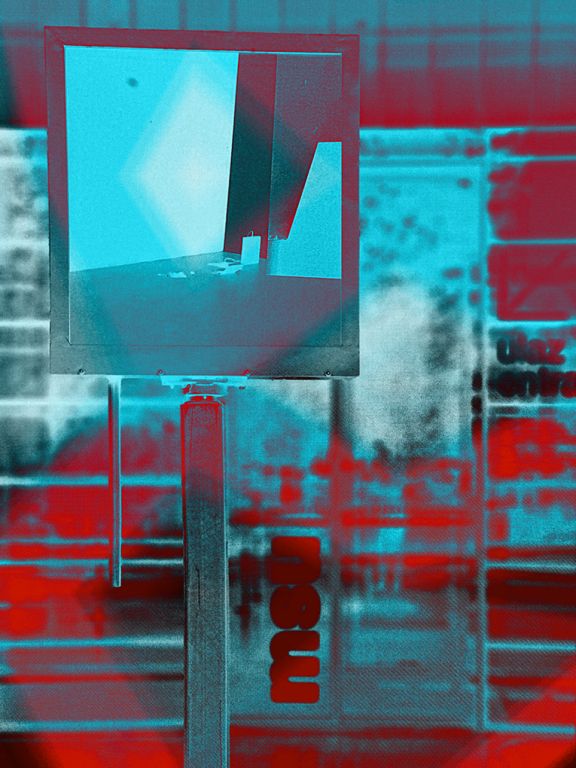Excitatory Yards
Participatory Public Space Installation For Two Rotatable Speaker Panels And Electronic Sound
Author: Jan St. Werner
with Michael Akstaller, Thomas Richter, Oliver Mayer, Marcin Pietruszewski
With his two experimental sound stations, Excitatory Yards, Jan St. Werner allows the architecture of MSU to be perceived in a conscious and unconventional way, as the installation functions as an acoustic amplification of the building and the outdoor space in dialogue with the visitors. A single loudspeaker is actively set in rotation by a visitor, triggering different directional sound signals and thus creating the opportunity to acoustically experience and explore MSU and its surroundings at different sound frequencies. In addition, the ear itself is activated and phantom sounds emerge.
The environments of the two sound situations – a small, enclosed one in front of MSU and a large one behind the museum are co-actors in a composition. This includes the two spaces as well as the deliberately disparate experiential movements of the visitors. Although the two ‘courtyards’ are part of an overall architectural concept, they are too far apart to be experienced simultaneously and together. As visitors explore them, they become intertwined: One remembers certain sounds, reflections, and perspectives and links them to the experiences of the slightly more distant surroundings; in individual perception, sound and environmental coordinates come together.
A greater awareness of the architecture, the space, and one’s own acoustic and visual experience in a game of distance and proximity is an essential part of the work.
Vibraceptional Plate
Commissioned by the SONCITIES research project at the University of Oxford, the Vibraceptional Plate serves both as a vibrating structure and a platform for investigating vibrational perception, which Jan St. Werner refers to as ‘vibraception.’ This project stems from St. Werner’s long-standing interest in sound as a spatial practice and his creation of anarchic architectures that use sound and psychoacoustics to challenge traditional architectural forms. The Vibraceptional Plate extends St. Werner’s collaboration with SONCITIES in exploring the potential of vibrational architectures—those that prioritize vibrational phenomena, including audible and inaudible sound, seismic waves, and mechanical waves—to disrupt and reorient architectural thinking.
Workshops connected to the Vibraceptional Plate will be conducted by a group of local and international scholars for architecture and art students in Zagreb, who will be invited to imagine what a vibrational architecture could be. These students will design new vibrational architectures, which will be shared on the SONCITIES website (soncities.org) and in future publications. As a participatory public artwork, the Vibraceptional Plate invites anyone to create, experiment, and explore the realm of vibrations and wavespace.
The Vibraceptional Plate is being exhibited for the first time at the Muzej Suvremene Umjetnosti, Zagreb, as part of the exhibition ‘Vibraception: Investigations in Wavespace,’ curated by Ana Škegro. It was conceived by Jan St. Werner and built by Michael Akstaller.
Concept and design: Jan St. Werner
Engineer: Michael Akstaller
Commissioned by: Gascia Ouzounian/SONCITIES
Curator: Ana Škegro
Workshop conveners: Jan St. Werner, Nikola Bojić, Brett Mommersteeg, Gascia Ouzounian, Ana Škegro
Sponsor: European Research Council (no. 865032)
Acknowledgements: Damir Gamulin, Polly Nuttgens, Rudy Schmidt, Faculty of Music at the University of Oxford
The SONCITIES project is a research initiative that explores the relationship between sound, urban environments, and architectural design. Based at the University of Oxford, the project investigates how sound can be used as a medium to rethink and reshape urban spaces and architectural practices. Led by Gascia Ouzounian, SONCITIES focuses on understanding how sound influences the way we experience cities and how it can be harnessed to create more dynamic, inclusive, and responsive urban environments.
This project has received funding from the European Research Council (ERC) under the European Union’s Horizon 2020 research and innovation programme as part of the project Sonorous Cities: Towards a Sonic Urbanism (grant agreement No 865032). Supported and co-produced by Muzej Suvremene Umjetnosti, Zagreb.
The Vibraception project is realized with the financing of the City of Zagreb and the Ministry of Culture and Media of the Republic of Croatia.

